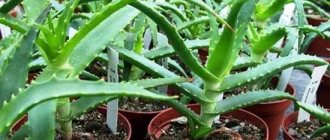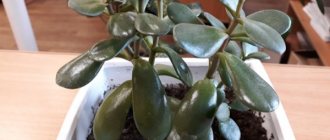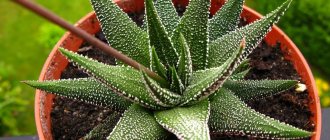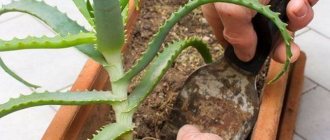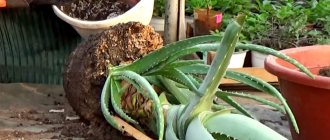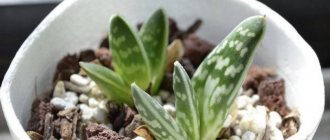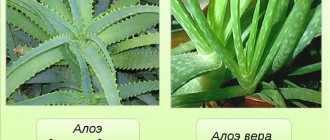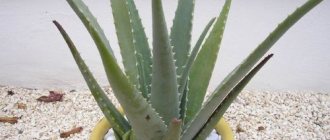Surely since childhood you have been familiar with the domestic representative of the Xanthorrhoeaceae family, and also with the medicinal Aloe. This succulent grows in many homes, its distinctive feature being fleshy leaves framed by thorns, arranged in a spiral in densely collected rosettes.
In the wild, there are about 500 species of plants growing in hot regions - Africa, the Mediterranean and Arabia. These species are very different in appearance; there are real giants - trees reaching a height of up to 20 meters. There are Liana-like Aloe and shrubs with long, about half a meter, spreading leaves. Decorative species of certain varieties grow in our homes. You can find out about the main ones in this article.
Read about caring for homemade aloe
Aloe tree (Aloear borescens) – Agave
At home, with proper care, it can grow up to 1 meter; in nature, there are representatives up to 5 meters in height. It has smooth fleshy leaves, greenish-blue in color, with teeth along the edges. In indoor conditions, the plant almost never blooms, but in nature, during the winter seasons, large reddish flowers with a pleasant aroma appear. Read more about the medicinal properties of agave.
Aloe Tree juice has antibacterial, anti-inflammatory and regenerating properties. If you accidentally cut yourself or burn yourself, you can anoint the wound with the juice of the plant, or apply a piece of pulp.
Types of aloe used in medicine
Aloe is known as a medicinal plant, but out of several hundred species, only a few are used for medicinal purposes.
Aloe is used for treatment:
- Tree-like;
- The present;
- Striped;
- Soapy;
- Barbadian;
- Frightening.
The most common is tree-like, or domestic. The chemical composition and properties of this plant have been well studied. In folk medicine, it is used both externally and internally, but not all of the effects attributed to the succulent have scientific confirmation.
Aloe vera or real aloe, which is also sometimes called Indian, has a similar chemical composition. It is its juice that is added to cosmetic products and medicines.
Mature aloe vera bush
In some cases, it is possible to use striped aloe instead of tree aloe. It is believed that preparations made from its juice and pulp have almost the same effects. This plant looks like this:
As you can see in the photo, its leaves are covered with numerous transverse white lines.
And this is what soap aloe (Aloe saponaria) looks like, which is used for medicinal purposes only in places where it grows naturally.
Aloe vera (Aloe ferox) has found wider use. It is used in the pharmaceutical industry. The plant has a tree-like shape and can reach a height of 3-5 m. Its leaves are large, up to 1 m in length. One sheet can weigh about 2 kg.
Aloe barbadensis miller (Aloe barbadensis miller), shown in the photo below, is also used on an industrial scale.
Only some species have a similar chemical composition and beneficial properties to aloe vera, while for most they differ greatly.
Interesting video: details about the medicinal properties of aloe
Aloe spinous (Aloe aristata)
This species is often confused with Haworthia due to their similar appearance. This plant has thick, arched leaves with a rough surface and white spots. At the end of the leaf there is a characteristic white thread. It usually blooms in late spring with red and orange tubular flowers collected in a raceme (Haworthia has white flowers).
To distinguish Aloe spinosa from Haworthia, you need to pay attention to the fact that Aloe is a solitary plant, and Haworthia has lateral children. Also, Aloe has a less pronounced pattern and convexity on the leaves. An adult Haworthia plant is small in size, in contrast to Aloe Spinata.
Medicinal types
Despite the fact that aloe is an ornamental plant, many people grow it from a practical point of view. Varieties with medicinal qualities include:
- Scarlet soap - stands out with a branched stem with a large number of rosettes. Fleshy leaves with white longitudinal strokes are edged with red thorns. Succulent leaf plates serve as excellent raw materials for creating antiseptics.
- Aloe Barbados or literally “aloe barbadensis” is a succulent with a shortened stem and a rosette consisting of hard bluish leaves reaching 60 cm in length. The almost vertically growing sword-shaped leaf plates along the edges are protected by sharp thorns. Racemose inflorescences on a 90 cm peduncle consist of yellow or red flowers. In literature and in everyday life, its second name is more widespread - aloe Vera.
- Treelike , also known as domestic aloe, is a species often found on window sills, popularly known as agave or aloe agave. A succulent in the form of a shrub or a strongly branching tree, reaching a height of 4 m, has succulent sword-shaped leaves edged with teeth. (Read more about agave here). When blooming, flowers bloom in various shades of yellow or red.
- Aloe intimidating or Aloe ferox is a powerful succulent up to 3 m in height with a single erect central shoot. Depending on the condition of the plant, the intense green color of the leaves, covered with red sharp thorns, may become scarlet under oppressive factors.
Advice! If the owner of one of the medicinal types suffers from a skin disease, then an antiseptic gel with the addition of aloe will help.
For preparation, the succulent itself is used, as well as plantain, chamomile, yarrow and sea buckthorn oil: juice is extracted from the plants, which is thoroughly mixed with oil. The gel is ready for use.
So, if you want to acquire a new, unpretentious plant that can also become a home healer, aloe is the ideal solution. And photos of different types will help you choose the most suitable one, both from a practical and aesthetic point of view.
Aloe humilis
A small herbaceous plant, with dense groups of spines along the edges of the leaves, and a large number of papillae on the outer side. The leaves have a linear-lanceolate structure. Throws out a long peduncle (20-30 cm) with red or orange flowers.
Also read: Growing Sedum (Sedum) in open ground. Variety of garden species. Care instructions
Species diversity
Varieties of aloe, of which there are about five hundred, are drought-resistant: their natural habitat is the Arabian Peninsula, Madagascar, and desert regions of Africa. Among the most common and extraordinary are the following:
- Aloe spinosa (aristata) is a stemless variety with a rosette of 15 cm thick leaf blades pointed at the top, strewn with small whitish spines. The succulent blooms with flowers of orange tones.
- Cosmo is a hybrid of spinous aloe, which resembles haworthia, but is more impressive in size.
- Aloe variegated - a miniature succulent, not exceeding 30 cm in height, has a rosette, which is formed by spirally arranged leaves. The scaphoid dark green leaves have a peculiar pattern for which the species is known as the scarlet tiger - wide transverse stripes or light spots.
A 20 cm peduncle, developing from a rosette, is crowned with an inflorescence of pinkish or orange-red flowers. - Squat is a compact, highly branched perennial with linear-lanceolate leaves forming a rosette. The surface of the green processes with a gray or blue tint is decorated with papillae and whitish spines along the edges. On a peduncle up to 35 cm long there is an inflorescence formed by red or orange flowers.
- Aloe Rauha is a medium-sized succulent whose fleshy, jagged leaves are triangular in shape, native to Madagascar. A 20 cm rosette consists of bluish stems 10 cm long, covered with small longitudinal white stitches. Over time, breeders have developed a number of ornamental varieties that have non-standard plate colors.
- Variety Donnie - stands out for its variegated dark green foliage, edged in the form of a strip of bright pink color;
- Snow flake variety is a succulent with almost white leaves, on the surface of which there are green strokes.
- Scarlet folded is a powerful perennial with a forked central shoot, reaching 5 m in height in the natural environment. Each branch at the end has a rosette formed by 12-16 ribbon-shaped leaves, the arrangement of which resembles a fan. The rounded leaf blade is grayish-green in color and has a smooth or slightly jagged edge.
- Aloe hedgehog is a small stemless succulent whose rosette consists of dark green leaves with sharp white spines that darken over the years. During the flowering period, yellow or red flowers bloom.
- Multileaf or spiral (commonly known as spiral) is a variety with fleshy, triangular-shaped foliage that forms a rosette, arranged in a spiral both clockwise and counterclockwise. Inflorescences, consisting of traditionally scarlet flowers, are formed on a peduncle 60 cm long.
- Aloe Jucunda - distinguished by intense green leaves with red teeth and white streaks on their surface. The inflorescences consist of 20-30 pink flowers, blooming alternately.
- Scarlet Somali is a larger version of the previous variety: the rosette of an adult specimen reaches 30 cm.
- Marlotta is a species that in its natural environment can reach 4 m in height and has a rosette of fleshy leaves. The silvery-blue leaf plate is covered with red-brown teeth. Flowering occurs when orange flowers bloom on a peduncle 80 cm long.
- Haworthia is an attractive species for succulent collectors: it is a variety of aloe, without which a mix is simply impossible. A miniature perennial with light cilia on the leaves that form small rosettes.
- Aloe oppositeifolia is a species of small size, the arrangement of the leaves of which is characterized by its name - they are opposite each other. The foliage with a bluish tint along the edges is covered with small red thorns.
- Camperi is a perennial 50 cm high with sword-shaped leaves, convex at the bottom. The glossy green arc-shaped stem has protective teeth.
- Aloe dichotomous is a tree-like plant that bears little resemblance to aloe, reaches 9 m in height. At the ends of the branches, rosettes are formed, consisting of powerful succulent leaves with thorns along the edges.
- Aloe strongly branched is a highly branched perennial up to 2 m that can withstand frosty weather. Blooms exclusively yellow.
- Aloe cap-shaped is a species with ovate-lanceolate leaves up to 20 cm long, colored gray-green with light-colored thorns along the edges. Scarlet flowers are collected in inflorescences, which are located on peduncles not exceeding 60 cm.
- Beautiful aloe is a species with dark green narrowed leaves covered with small white spots, warts and spines along the edges. The bell-shaped flowers are painted in shades of scarlet.
- Scarlet white -flowered is a stemless variety with basal rosettes that are formed from grayish lanceolate leaves. It is distinguished by white patches and spikes on the leaf blades, and flowers of a similar color.
You can see what this plant looks like when it blooms in the video:
- Aloe Jackson is a native of Ethiopia with glossy light green stems that are decorated with white streaks and a single thorn at the tip.
- Aloe Desconigsa is a miniature star-shaped succulent with elongated, triangular-shaped leaves that form a rosette. The covering of the leaf plates, which have a wide range of colors, consists of many thorns.
This species is sometimes also called Aloe Desquana; this video describes the features of care:
- Black-thorned aloe is a herbaceous perennial, the height of which does not exceed 50 cm, and stands out among other species by its spines on the back of the leaf blade.
- Black Jam variety - breeders, having worked with the scarlet black-thorn variety, developed a special variety: a miniature rosette succulent changes the color of its leaves from intense green to red when exposed to sunlight for a long time.
- Aloe vera is a fairly large plant up to 3 m in height with a creeping stem covered with rounded leaves up to 10 cm pointed at the top.
- Aloe vera is a succulent with a powerful stem that forms many rosettes. The latter consist of green leaves covered with white streaks. When flowering, two-color brushes are visible on the peduncle.
Aloe Vera
Like Scarlet Tree, it has medicinal properties. It is distinguished by fleshy leaves with a high water content (97%). The leaves have pale white patches. The composition of this species is very rich in minerals, amino acids, enzymes and beta-carotene. Actively used in cosmetology and medicine. In care, a moderate watering regime should be observed.
Read more about Aloe Vera care and healing properties.
Aloe variegata – Tiger Aloe
Variegated aloe is thornless and has dark green smooth leaves with a characteristic tiger pattern. Differs in slow growth. You need to be careful and moderate when watering so that water does not fall on the plant (this can lead to rot and death of the plant). You should also carefully accustom the plant to direct sunlight (it is very sensitive), and it is better to arrange shading if you have a south window. Flowering with red-orange inflorescences.
General characteristics of the type and features of care
The succulent aloe plant, popularly known as agave, belongs to the Asphodelaceae family. It grows very slowly and rarely blooms indoors. Most plant species do not have a stem. The leaves are collected in a basal rosette. This flower is quite resistant to sudden changes in climatic conditions. The pulp of the leaf contains a large amount of moisture. In unfavorable conditions, the pores on the surface of the leaf close, this allows moisture to be retained, which makes the flower more stable.
Agave requires good lighting, so it is best to grow it in sunny windows. In winter, it is not necessary to create a warmer temperature in the room, since the plant grows well at temperatures from 10℃ at this time of year.
Watering should be plentiful in summer and moderate (once a week) in winter. Does not require spraying. The advantage is that the plant is practically not prone to disease and is rarely damaged by pests. Aloe propagates by seeds and shoots.
Note!
Transplantation is recommended in March or April, no more than once every 2 or 3 years.
Aloe erinacea
It has dense dark green leaves with sharp thorns. As they mature, the tips of the leaves and spines darken. The plant is small, bushy. In nature it blooms with tubular flowers of red and yellow colors. There are species with white spines; in some, the spine length can reach 1.5 cm.
Also read: Haworthia - popular species and care at home
Aloe propagation methods
At home, aloe can be easily propagated in two ways - seeds or shoots.
Seed propagation
Ready-made aloe seeds can be purchased at flower shops or obtained from dried stems.
You need to make a drainage layer in the seed container and fill it with a ready-made mixture of sand, turf and leaf soil. Plant the seeds. Place the container in a shaded, well-ventilated room, where the temperature will be maintained at 20 degrees Celsius throughout the entire time of seed germination.
Seeds do not need abundant watering, but daily.
Shoots should appear in two weeks. When the sprouts are one month old, each of them needs to be transplanted into a separate pot. After 3-4 months, young aloe plants need to be transplanted again into larger containers and put into care mode as for adult plants.
The best time to sow seeds is the end of winter - the beginning of spring.
Reproduction by shoots
The easiest way to propagate is through shoots. To do this, you need to carefully separate several young shoots from the main outlet and plant them in a separate container.
The soil for shoots should have the same composition as for seeds.
At low temperatures (up to 20 degrees), diffused light and daily watering, the shoots will quickly release roots and begin to stretch upward. As soon as these processes become noticeable, the plant can be considered an adult and general care rules can be applied to it.
The selection of young shoots should be carried out in early summer.
Aloe Polyphylla - Aloe Spiral
A very beautiful species, with fleshy, triangular, pointed leaves arranged in a spiral. Flowering only in natural habitat - long peduncle up to 60 cm) with pink, rose-red or yellow flowers. The number of leaves per rosette, as a rule, is no more than 30 pieces. Quite a rare species. The spiral can grow clockwise or counterclockwise.
Aloe albiflora
The species is small in size with narrow serrated leaves of gray-green color. There are light blotches on the leaves. At home, it blooms in winter (with proper care throughout the year) with white inflorescences that look like elongated bells with green shelves. Growth is slow, not whimsical. Tolerates partial shade well.
Read about caring for homemade aloe.
General description of plants of the genus Aloe
Plants of the genus Aloe, which includes perennial leafy succulents and xeophytes of herbaceous, shrub and tree forms, belong to the Asphodelaceae family. Plants of this genus can differ significantly in appearance. Some species are very miniature and reach a height of only 20 cm, while others, especially tree-like ones, can grow up to 3 meters or more.
A characteristic feature of all species is the structure of their leaves. They can be wide and short, almost triangular in shape, or narrower and longer, such as in aloe vera. In some plants, the leaves have an almost smooth surface and are covered only with soft cilia, while in others, on the contrary, they can be completely covered with thorns.
Aloe leaves have a dense shell and a fleshy structure. Due to this, as well as division into special cells, a large amount of liquid accumulates in the leaves, allowing succulents to endure long periods of drought. The preservation of moisture is also facilitated by the narrowing of the pores of the leaves, which occurs when the air temperature rises and the flow of water decreases. Thanks to this feature, these plants can survive without watering for up to several months.
A cut of aloe leaves shows how much liquid is in their cells
These plants bloom mainly in natural conditions. When growing at home, this happens quite rarely and only with proper care. During the flowering period, aloe grows a peduncle with a racemose inflorescence, on which small tubular flowers are formed. They can be white, yellow, red, burgundy and some other colors.
This photo shows a flowering bush:
The natural habitat of different types of aloe is the arid regions of Africa, the island of Madagascar and the Arabian Peninsula. It is there that you can get acquainted with all the diversity of species of this genus.
Aloe is undemanding not only to watering, but also to soil and temperature conditions. Thanks to this, plants transported to other regions adapt well to new climatic conditions. Now these succulents are grown in almost all countries of the world; they are planted both in open ground and at home in flowerpots.

